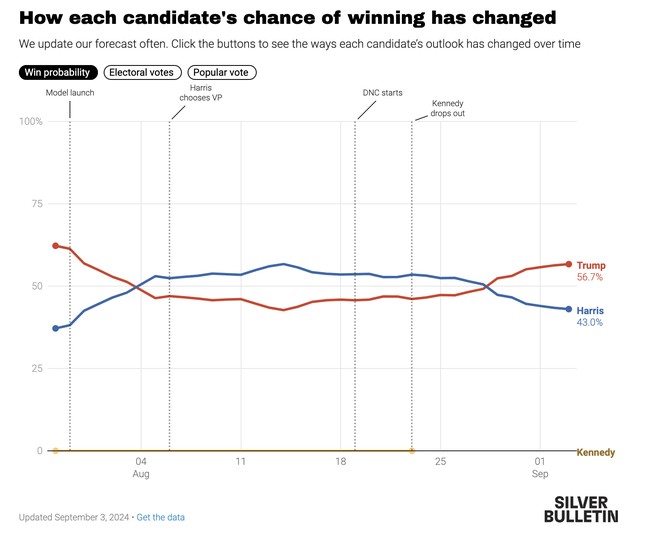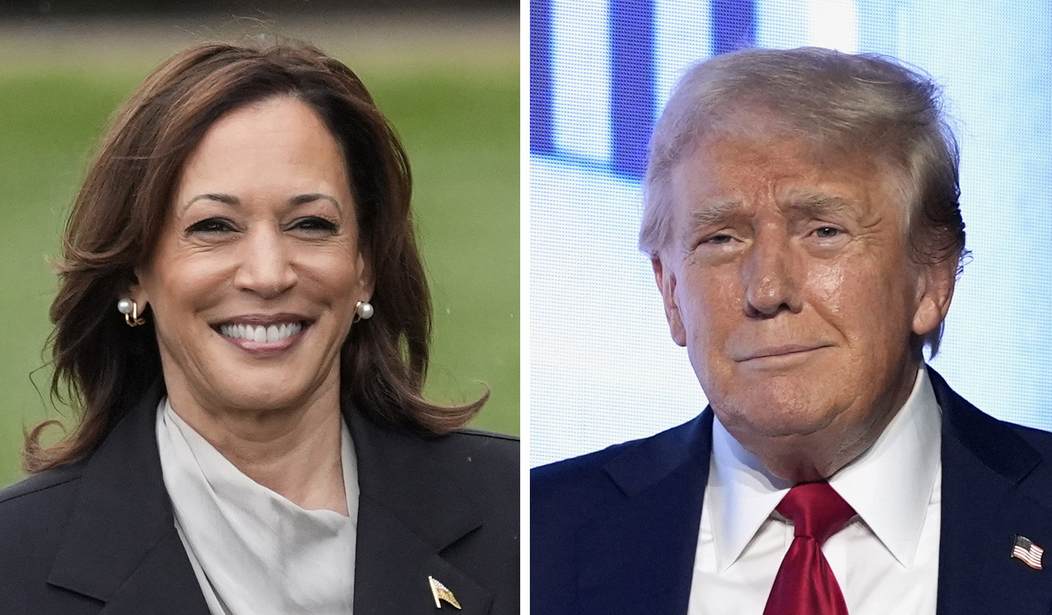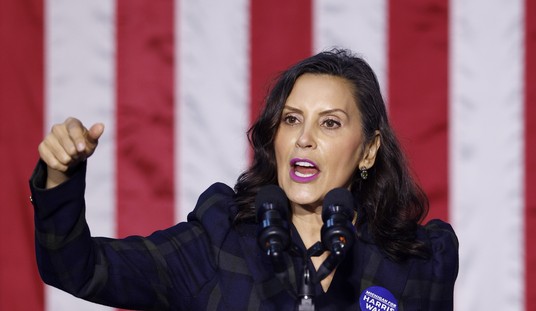Nate Silver is in the political prediction game, and as with all oddsmakers, his predictions are based on a model with a "secret sauce" that he claims makes it better than the rest, and as with all oddsmakers, the rest disagree with him on what the best secret sauce really is.
I am very much in the Yogi Berra school of predictions: "It is difficult to make predictions, especially about the future."
But while predictions are hard, calculating the odds is hardly a worthless exercise. When an event has a 75% chance of occurring, you haven't blown the prediction if the event that had a 25% chance of occurring actually happened. That's like saying getting heads on a coin flip four times in a row proves that the odds weren't 50-50.
Of course, suppose you are consistently wrong in your oddsmaking. In that case, your secret sauce could be less tasty than we like, so iteration is the only way to test your hypothesis about calculating those odds, and Nate has a decent record of predicting election results. And he is transparent about how he gets his numbers and what his record is:
Let’s cut to the chase: So, who’s gonna win the election?
Well, honestly, we don’t know — but we can give you our best probabilistic guess. This is the landing page for the 2024 Silver Bulletin presidential election forecast. It will always contain the most recent data from the model.1
The model is the direct descendant of the f/k/a FiveThirtyEight election forecast2 and the methodology is largely the same, other than removing COVID-19 provisions introduced for 2020. Other changes from 2020 are documented here. And an archive of the Biden-Trump forecast can be found here.
With all this in mind, let's take a look at why Nate's model currently predicts that Trump has better odds of winning than Kamala Harris. Not HUGELY better, but significantly so.
 According to Nate, Trump has a 10-15%+ better chance of winning the election than Kamala Harris does at this moment.
According to Nate, Trump has a 10-15%+ better chance of winning the election than Kamala Harris does at this moment.
Before you get too excited, note two things: 12% is not so much, and as you can see, the predictions are based on conditions AT THIS MOMENT and hence can move significantly. Back in June, Trump had a much better chance of winning than now, and as new information comes in, the odds can and will change.
As they say, the only poll that matters is the one that comes out on election day or, in our screwed-up world the first three weeks of November.
Learn to count Democrats. And count fairly.
Silver's "secret sauce" is using the polls in such a way that they are less volatile than most prediction models. He accounts for natural bumps, such as the conventions.
Silver's analysis of why things are moving Trump's way is more complicated than I can explain, but he does provide a summary of why his model is souring on Harris:
As you can see from the forecast chart, Harris’s odds have declined slightly over the past two weeks, as she’s gone from roughly a 55/45 favorite to a 45/55 underdog. It’s not a huge change. Probability calculations can be highly sensitive just to either side of the 50/50 mark. If the New York Knicks make a buzzer-beater just before halftime to go from trailing the Boston Celtics 61-60 to leading them 62-61, they might tick over from “underdog” to “favorite” in a win probability model. But it isn’t as though the game has been fundamentally transformed. Still, the decline in Harris’s forecast reflects three factors:
(1) Harris is slightly underperforming the model’s benchmark for a convention bounce. Harris is, in fact, polling a bit better now than before the DNC — but only a bit better, with a 3.5-point lead in our national polling average as of Sunday versus 2.3 points before the convention. The model’s baseline expectation was a bounce of more like 2 points. By the model’s logic, she’s gone from a lead of 2.3 points to a convention-bounce adjusted lead of 1.5 points. That’s not a game-changing difference, but it’s enough to show up in the bottom line.
(2) Kennedy dropping out of the race. We initially expected this to hurt Harris by 0.5 points or less, given that RFK Jr. drew more Trump voters than Harris voters but only slightly more. However, it’s plausible that the impact is larger with RFK having not just dropped out but endorsed Trump.
Given the timing of Kennedy’s announcement, this factor is all but impossible to disentangle from the convention bounce or lack thereof. Our model run on Friday, August 23 — the day just after Harris’s acceptance speech and the day that Kennedy dropped out, but before we switched over to the RFK-less version of the model -– showed Harris ahead by 4.7 points in our national average. That suggested she was on her way to a typical convention bump of 2 or 2.5 points — or possibly more, given that the impact of the convention probably hadn’t yet been fully realized in the polling.
Now, our polling averages are designed to be very aggressive after big events like conventions, and maybe 4.7 points was an overestimate since it was drawn from relatively few polls. Occam’s Razor, though, is that Harris — who gave an effective speech — was on her way to a typical but not extraordinary convention bounce, and then Kennedy’s dropout/endorsement ate into those gains. I somewhat regret the framing of my story from Aug. 24, which warned that the model could be running a “little hot” on Harris because the impact of RFK hadn’t really been factored in yet, but had a headline that emphasized how there hadn’t been much change yet. If I had to do it over again, I’d instead headline the story with something that underscored the need for a wait-and-see approach.
(3) Comparatively poor polling for Harris in Pennsylvania, which is disproportionately important given Pennsylvania’s likelihood of being the pivotal state. As a result, the Electoral College forecast has swung more than the popular vote forecast.
Now one can argue that any election with Trump is inherently unpredictable--he is a bull in the model China shop--and that 2024 is even less predictable than usual because of all the weird events that have happened over the past 6 weeks. And you would be right to do so.
But my gut tells me that this model is picking up something that is real: Harris's honeymoon is coming to an end, and momentum is swinging back to Trump as people get over their relief that the lobotomized Biden is out of the race. This will be more like the 2020 election than it was before the Biden exit.
Republicans have been a bit glum about the election at least partly due to Biden's exit and the firehose of propaganda from the mainstream media, but I suspect that Harris' and Walz's weaknesses will bring them down to earth, just as Americans learned to ignore the propaganda about how great the economy is.
Silver's model is behind a paywall and not a cheap one. But I subscribed because Silver drives a lot of conversation.
With that said, it would be unethical to provide constant updates on what he says; he needs to make a living too. But I will drop in from time to time to see if he is making news or telling us something that the more public prediction models aren't.
And in November we will find out if he really is better than the average prophet.








Join the conversation as a VIP Member